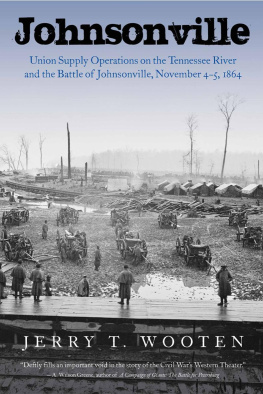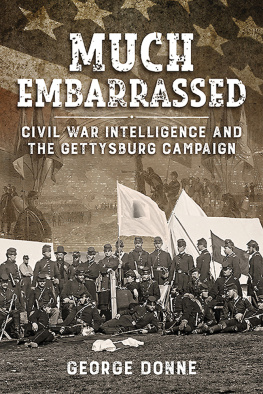

Published by The History Press
Charleston, SC 29403
www.historypress.net
Copyright 2012 by Michael R. Bradley and Shirley Farris Jones
All rights reserved
First published 2012
e-book edition 2012
ISBN 978.1.61423.474.6
Library of Congress Cataloging-in-Publication Data
Jones, Shirley Farris.
Murfreesboro in the Civil War / Shirley Farris Jones and Michael R. Bradley.
p. cm.
Includes bibliographical references.
print ISBN 978-1-60949-459-9
1. Murfreesboro (N.C.)--History--19th century. 2. North Carolina--History--Civil War, 1861-1865. 3. Murfreesboro (N.C.)--Biography. I. Bradley, Michael R. (Michael Raymond), 1940- II. Title.
F264.M9J67 2012
975.603--dc23
2012002972
Notice: The information in this book is true and complete to the best of our knowledge. It is offered without guarantee on the part of the authors or The History Press. The authors and The History Press disclaim all liability in connection with the use of this book.
All rights reserved. No part of this book may be reproduced or transmitted in any form whatsoever without prior written permission from the publisher except in the case of brief quotations embodied in critical articles and reviews.
This book is most respectfully dedicated as a 150th Anniversary Tribute to Murfreesborough during the Civil War.
To the townresistant to the point of being captured but strong enough to survive the occupation of both Armies.
To her sons and soldierswho fought valiantly for the cause they believed to be right, whether North or South; who suffered, who bled, who died.
To her citizensmen and women, young and old, black and white, who stayed behind and kept the home fires burning; who possessed the humanity to feed and nurse the wounded of both sides; and who had the courage to pick up the pieces and move forward together into the next century to make us who we are today.
Contents
Acknowledgements
Our thanks is offered to the many people who have assisted in the research and preparation of this book. We were warmly received by the Albert Gore Research Center at Middle Tennessee State University. Dr. James H. Williams has a wonderful staff for the center led by Mr. James Havron, archivist and coordinator, and ably assisted by Kelsey Fields, graduate assistant. The Gore Center holds a wealth of information about Murfreesboro during the Civil War years. The staff of the History Room at the Linebaugh Public Library in Murfreesboro were always available to assist in tracking down elusive bits and pieces of materials, especially microfilm of newspapers.
At Stones River National Battlefield Park, Mr. Gilbert Backlund, Mr. Jim Lewis and Mr. John R. George all gave freely of their time and knowledge to assist this effort. The staff at Oaklands has been quite gracious in providing photos of the interior and exterior of the house and in answering questions about the visit of Jefferson Davis to the Maney home. Special thanks to Nila Gober at Oaklands for her enthusiastic help.
The Storm Clouds Gather
SECESSION CRISIS
The pretty little town of Murfreesboro was barely fifty years old when it became a focal point of the Civil War in the West. From 1811, when the town was founded, until 1861, life in the town had been interesting but hardly dramatic.
From 1818 to 1826, Murfreesboro was the capital of the state, but political maneuvering moved the seat of government elsewhere, and Nashville became the permanent location of state government in 1843. Meanwhile, Murfreesboro was growing. Twenty saloons were open to quench the thirst of residents and visitors, while four hotels served the needs of travelers. Many private homes took in the weary, and all accommodations were usually full when court was in session. By 1830, there was a theater, though the members of the towns numerous churches stayed away from the questionable moral atmosphere of the playhouse. That same year, a stagecoach line linked Murfreesboro with Nashville to the north and with Huntsville, Alabama, far to the south. Education flourished with Bradley Academy, founded in 1809, attracting students such as future president James K. Polk, and Union University, founded in 1823, drawing students from across the entire region. Schools for young ladies included Soule Academy, named for Bishop Soule of the Methodist Church. A cotton factory, a carriage factory, a manufacturer of cedar buckets, a flour mill and similar light industry were stimulated by the construction of the Nashville & Chattanooga Railroad, whose first cars ran along the new line in 1851. Around the courthouse square were to be found general merchandise stores, two drugstores, a bookstore, jewelry stores, a livery stable and a hardware store. By 1860, there were thirty-five manufacturing concerns in and near Murfreesboro, employing 136 workers, and the town was building a municipal gasworks. The new courthouse (still in use) was completed in 1859 at a cost of $50,000.
Within the city limits, the 1860 census shows a population of 3,861, with 121 of these being listed as slaveholders. This group of citizens held 891 slaves. A few slave owners had as many as a dozen slaves, but many held only 1 or 2. J.B. Palmer, mayor of Murfreesboro from 1855 to 1859 and a future Confederate brigadier, held 9 slaves. Four were male, all minor children; 5 were females, of which one was a minor.
Politically, Murfreesboro had a strong Whig inclination. Nationally, the Whigs favored the use of tax money to support internal improvements such as improving navigation on rivers, having the government construct roads and providing subsidies for railroads. Murfreesboro voters frequently favored the Whig candidates for state and national offices, while local elections were hotly contested and political rallies were popular social occasions. Then came the presidential election of 1860. Murfreesboro Whigs were in a state of disarray. Since 1853, their party had been less and less effective on the national level and had failed to select a candidate for president in 1856. In the North, many Whigs had joined the Republican Party, whose economic views were quite similar to those of the Whigs. In the South, the Republicans were viewed as a sectional party, and the old Whigs did not wish to join them; on the other hand, Murfreesboro Whigs reflected a common viewthey had never voted for a Democrat, and they did not intend to do so in 1860. The result was the organization of a new group called the Constitutional Union Party, with Senator John Bell of Tennessee as its standard-bearer. This party proved to be short-lived, but it provided a political home for Tennessee Whigs in 1860.
The Democrats held a convention in Charleston, South Carolina, in the summer of 1860 but failed to nominate a candidate after not being able to agree on a platform position dealing with slavery. Subsequent meetings produced two candidates: Stephen A. Douglas of Illinois and former vice-president John Breckinridge of Kentucky. Bell, Douglas and Breckinridge were the presidential candidates among whom the voters of Murfreesboro, and Tennessee, would choose in November 1860. Abraham Lincolns name did not appear on the ballot in Tennessee or other Southern states because there was no Republican organization in those states to collect signatures on a qualifying petition.
Beginning in September 1860, the supporters of the various candidates started to promote their men. Former mayor and future Confederate officer J.B. Palmer spoke out for Bell. The editor of the
Next page









